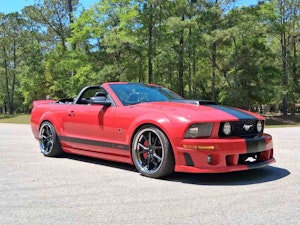Media | Articles
Ditch that LS, your next engine swap should be this 589 flat-six Tucker
Preston Tucker had some wild ideas, and one of the craziest was to build his dream car’s engine from scratch. Only a few came together before the plan was scrapped and the production replacement—from a helicopter—made its way into the engine compartment. Now, one of the original prototype engines could find its way into your project car.
Before you start looking for transmission adapters for this goofy horizontally-opposed six-cylinder, let’s talk history. Tucker was among the last of the start-up companies to challenge the major manufacturers, and production challenges for the Model 48 were seemingly endless. One of the biggest hurdles revolved around this very engine.
The massive 589-cubic-inch flat-six was penned by Ben Parsons. Sporting a five-inch bore and stroke, the engine is officially known as the Tucker A-589 and was a marvel of engineering. A few myths swirled around the development of this engine and the car, years after Tucker was forced to fold. One such myth was that the engine case was to be cast of magnesium.
In an interview with Speed Age, an auto magazine circulated from 1947–59, Parsons said the engine case was never meant to be magnesium—only the oil pan was. The engine case was cast aluminum, but the magnesium oil pan was designed to offset the detrimental effects of the acid which develops in oil as a byproduct of combustion.
Marketplace
Buy and sell classics with confidence
20190925160259)
The entire design centered on well-rounded performance with low stress on components. Peak power of 150 horsepower and 450 lb-ft of torque was achieved at just 1800 rpm, incredibly low compared to all but massive marine engines. That didn’t mean the working components were simple, however. The engine featured hydraulically actuated valves, meaning a standard camshaft wasn’t needed. Instead, there was a single-cam lobe which actuated a plunger, allowing pressurized oil to act on a piston which opened the individual valves. This quiet system also allowed for more efficient valve placement, since there was no rocker or pushrod geometry to worry about.
Parsons claimed this valvetrain could easily handle high rpm if the design would have changed to a lower-displacement/higher-rpm setup. Even the casting of the engine was designed to take higher rpm thanks to integral cylinder heads—and thus, no head gaskets that could potentially fail.
Yet this highly innovative engine never reached production. Instead, the complicated piece of machinery was shelved, and a 335-cu-in flat-six from Air-cooled Motors, Inc., took up residence in the 51 Tuckers built. This new engine was mainly used in helicopters, prior to Tucker. The differences between the prototype “Tin Goose” and Tucker production cars were questioned by the U.S. Securities and Exchanges Commission, leading to fraud charges being brought against Tucker. Even with Preston Tucker’s ultimate acquittal of all charges, the automaker was a financial bust.
Only three of the highly advanced Tucker engines were produced prior to the switch, which makes the hulk offered at Mecum’s upcoming Louisville auction worth restoring. Might it be expensive? Sure. However, difficult tasks are still worth doing, and something like this deserves the care and attention befitting its rarity and historical significance.
20190925160237)








20190925160241)
20190925160245)
20190925160250)
20190925160255)
20190925160304)

